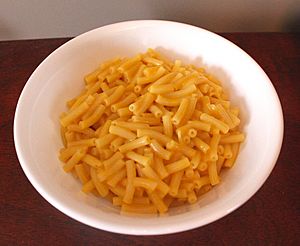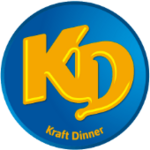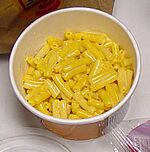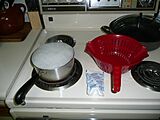Kraft Dinner facts for kids

A bowl of the original recipe Kraft Dinner
|
|
| Owner | Kraft Heinz |
|---|---|
| Introduced | 1937 |
| Markets | United States and Canada |
| Previous owners | Kraft Foods Inc. (1937–2012) |
Kraft Dinner is a popular brand of packaged macaroni and cheese. You might know it by a different name depending on where you live. In Canada, it's called KD. In the United States, Australia, and New Zealand, it's known as Kraft Mac & Cheese.
This easy-to-make meal comes in a box with two main things: dry macaroni pasta and a packet of powdered processed cheese. It was first sold in 1937 and is made by the Kraft Heinz company.
Kraft Dinner is especially loved in Canada. On average, Canadians eat 55% more boxes of it than Americans do.
Over the years, Kraft has created many new versions of this classic meal. There are "deluxe" types with liquid cheese sauce and single-serving cups called Mac & Cheese Dinner Cups that you can cook in the microwave oven.
The original idea was simple but smart. It offered a cheap and tasty meal that could be stored for a long time without going bad. To make it, you just cook the pasta and then mix in the cheese powder with some butter and milk.
Contents
History
How It All Started
The story of Kraft Dinner begins with the invention of processed cheese. This is a special kind of cheese that is made to last a long time on a shelf without needing a refrigerator. An inventor named James Lewis Kraft got a patent for this process in 1916.
During the Great Depression, a time when many people had little money, a salesman in St. Louis, Missouri, had a clever idea. He started attaching packets of grated cheese to boxes of macaroni pasta with a rubber band.
In 1937, the Kraft company took this idea and launched Kraft Dinner in the U.S. and Canada.
Success During World War II
The timing was perfect. During World War II, certain foods like milk and dairy were rationed, meaning people could only buy limited amounts. Families needed easy, meat-free meals, and many women were working in factories instead of at home.
Kraft Dinner became a popular choice because it was a filling meal for the whole family. It could also last for ten months on a shelf, which was great since not everyone had a refrigerator back then. Plus, it was cheap. For just one food ration stamp, a family could buy two boxes.
During the war, over 50 million boxes were sold. The original box was mostly yellow, but in 1954, it was changed to the bright blue color that is famous today.
Changes Over the Years
Kraft has continued to change and improve its mac and cheese over the decades.
- In 1975, a version with spiral-shaped noodles was introduced.
- In 1984, Velveeta Shells & Cheese came out, offering a creamier cheese sauce.
- In 2007, the pasta was changed to include 50 percent whole grain.
For a long time, the mac and cheese sold in the U.S. used artificial colors like Yellow 5 and Yellow 6 to make the sauce look more yellow. In 2015, Kraft announced it would stop using artificial flavors, preservatives, and colors in its recipe. Now, it uses natural spices like paprika, annatto, and turmeric for color.
A Canadian Favorite
Many people say Kraft Dinner is the unofficial national dish of Canada. Canadians love it so much that they buy 1.7 million boxes every week. The average Canadian eats about 90 million boxes a year!
In Canada, the meal is so famous that most people just call it "KD." It has become a generic trademark, which means some people use the name "Kraft Dinner" to refer to any brand of macaroni and cheese.
Some famous Canadians have talked about their love for KD. The rock band Barenaked Ladies mentions it in their song "If I Had $1000000". They sing that even if they were millionaires, they would still eat Kraft Dinner. Because of this lyric, fans used to throw boxes of KD on stage at their concerts. The band later asked fans to donate the boxes to food banks instead.
Former Canadian Prime Minister Paul Martin said it was his favorite food. Another former Prime Minister, Stephen Harper, also said he cooked it for his kids and liked to add hot dogs.
How to Make It
The box gives a simple three-step guide to making Kraft Dinner.
- Boil: You boil water in a pot and add the pasta.
- Drain: After the pasta is cooked, you drain the water using a colander.
- Add: You put the pasta back in the pot and add the cheese powder, milk, and butter or margarine. Then you mix it all together.
The box suggests using 6 cups of water, 1 tablespoon of margarine, and 1/3 cup of skim milk. However, many people change the recipe to make it just the way they like it. Some add more cheese, while others might add hot dogs or other ingredients.
Different Kinds of Kraft Dinner
Today, there are many different types of Kraft Mac & Cheese.
- Original Recipe: The classic box with dry macaroni and powdered cheese.
- Deluxe: This version uses a creamy, liquid cheese sauce that comes in a pouch. The pasta is also a different shape (elbow macaroni).
- Dinner Cups: These are single-serving cups that you can quickly make in the microwave. They are very popular with college students.
- Restaurant Version: A frozen, pre-made version is sold to restaurants like Burger King and Applebee's.
In 2021, Kraft also released "Flavour Boosts" in Canada. These are small packets of seasoning you can add to your mac and cheese to give it a new taste, like jalapeño or butter chicken.
Shapes and Flavors
Besides the original, Kraft Dinner comes in many fun shapes, often based on characters from movies and TV shows like Super Mario Bros. and Star Wars. There are also alphabet and number shapes. You can also find organic and whole-grain versions.
Marketing and Fun Facts
The product was first advertised as "a meal for four in nine minutes for an everyday price of 19 cents." In the U.S., it was heavily advertised to kids with the slogan, "Ask for The Blue Box."
In 2010, Kraft sponsored the demolition of Texas Stadium, the old home of the Dallas Cowboys football team. They held a contest for kids, and the winner, an 11-year-old boy who started a charity for the homeless, got to push the button that started the demolition.
Nutrition
| Nutritional value per 100 g | |
|---|---|
| Energy | 382 kcal (1,600 kJ) |
|
71 g
|
|
| Sugars | 11 g |
| Dietary fiber | 2 g |
|
5.4 g
|
|
| Saturated | 1 g |
| Trans | 0 g |
|
Protein
|
11 g
|
| Vitamins | Quantity
%DV†
|
| Vitamin D |
0%
0 μg |
| Minerals | Quantity
%DV†
|
| Calcium |
15%
145 mg |
| Iron |
25%
3.3 mg |
| Potassium |
8%
250 mg |
| Sodium |
56%
836 mg |
| †Percentages estimated using US recommendations for adults. Source: FoodData Central, USDA |
|
A serving of prepared Kraft Dinner is mostly carbohydrates, with some protein and fat. It is high in sodium (salt) and is a good source of iron.
Gallery
See also
 In Spanish: Kraft Dinner para niños
In Spanish: Kraft Dinner para niños











